Novel Boronate Probe Based on 3-Benzothiazol-2-yl-7-hydroxy-chromen-2-one for the Detection of Peroxynitrite and Hypochlorite
Abstract
1. Introduction
2. Results
2.1. Synthesis
2.2. Spectroscopic Response of BC-BE
2.3. Reactivity towards Biological Oxidants
2.4. The Effect of Compounds on Cell Metabolic Activity
3. Materials and Methods
3.1. General
3.2. Synthesis of 3-(Benzo[d]thiazol-2-yl)-2-oxo-2H-chromen-7-yl Trifluoromethanesulfonate (BC-OTf)
3.3. Synthesis of 3-(2-Benzothiazolyl)-7-coumarin Boronic Acid Pinacol Ester (BC-BE)
3.4. Real-Time Monitoring of Oxidation BC-BE Boronic Probe in Cell-Free System Generating ●NO and O2●–
3.5. Cell Culture and Exposure Conditions
3.6. Cell Metabolic Activity
4. Conclusions
Supplementary Materials
Author Contributions
Funding
Institutional Review Board Statement
Informed Consent Statement
Data Availability Statement
Conflicts of Interest
Sample Availability
References
- Cao, D.; Liu, Z.; Verwilst, P.; Koo, S.; Jangjili, P.; Kim, J.S.; Lin, W. Coumarin-based small-molecule fluorescent chemosensors. Chem. Rev. 2019, 119, 10403–10519. [Google Scholar] [CrossRef]
- The Colour Index™. Available online: https://colour-index.com/ (accessed on 10 April 2021).
- Sokołowska, J.; Czajkowski, W.; Podsiadły, R. The photostability of some fluorescent disperse dyes derivatives of coumarin. Dye. Pigment. 2001, 49, 187–191. [Google Scholar] [CrossRef]
- Telange, D.R.; Nirgulkar, S.B.; Umekar, M.J.; Patil, A.T.; Pethe, A.M.; Bali, N.R. Enhanced transdermal permeation and anti-inflammatory potential of phospholipids complex-loaded matrix film of umbelliferone: Formulation development, physico-chemical and functional characterization. Eur. J. Pharm. Sci. 2019, 131, 23–38. [Google Scholar] [CrossRef]
- Mahoney, K.M.; Goswami, P.P.; Winter, A.H. Self-immolative aryl phthalate esters. J. Org. Chem. 2013, 78, 702–705. [Google Scholar] [CrossRef]
- Li, L.; Zhang, M.; Chang, K.; Kang, Y.; Ren, G.; Hou, X.; Liu, W.; Wang, H.; Wang, B.; Diao, H. A novel fluorescent off–on probe for the sensitive and selective detection of fluoride ions. RSC Adv. 2019, 9, 32308–32312. [Google Scholar] [CrossRef]
- Salahuddin, S.; Renaudet, O.; Reymond, J.-L. Aldehyde detection by chromogenic/fluorogenic oxime bond fragmentation. Org. Biomol. Chem. 2004, 2, 1471–1475. [Google Scholar] [CrossRef]
- Gu, X.; Zhu, H.; Yang, S.; Zhu, Y.-C.; Zhu, Y.-Z. Development of a highly selective H2S fluorescent probe and its application to evaluate CSE inhibitors. RSC Adv. 2014, 4, 50097–50101. [Google Scholar] [CrossRef]
- Bae, J.; Choi, J.; Park, T.J.; Chang, S.-K. Reaction-based colorimetric and fluorogenic signaling of hydrogen sulfide using a 7-nitro-2,1,3-benzoxadiazole–coumarin conjugate. Tetrahedron Lett. 2014, 55, 1171–1174. [Google Scholar] [CrossRef]
- Wang, L.; Li, W.; Zhi, W.; Ye, D.; Wang, Y.; Ni, L.; Bao, X. A rapid-responsive fluorescent probe based on coumarin for selective sensing of sulfite in aqueous solution and its bioimaging by turn-on fluorescence signal. Dye Pigments 2017, 147, 357–363. [Google Scholar] [CrossRef]
- Zhang, D.; Chen, W.; Kang, J.; Ye, Y.; Zhao, Y.; Xian, M. Highly selective fluorescence off–on probes for biothiols and imaging in live cells. Org. Biomol. Chem. 2014, 12, 6837–6841. [Google Scholar] [CrossRef] [PubMed]
- Sun, W.; Li, J.; Li, W.H.; Su, L.J.; Du, L.P.; Li, M.Y. Design of OFF/ON fluorescent thiol probes based on coumarin fluorophore. Sci. China Chem. 2012, 55, 1776–1780. [Google Scholar] [CrossRef]
- Badalassi, F.; Wahler, D.; Klein, G.; Crotti, P.; Reymond, L.-J. A versatile periodate-coupled fluorogenic assay for hydrolytic enzymes. Angew. Chem. Int. Ed. 2000, 39, 4067–4070. [Google Scholar] [CrossRef]
- Nyfeler, E.; Grognux, J.; Wahler, D.; Reymond, J.-L. A sensitive and selective high-throughput screening fluorescence assay for lipases and esterases. Helv. Chim Acta 2003, 86, 2919–2927. [Google Scholar] [CrossRef]
- Xue, F.; Seto, C.T. Fluorogenic peptide substrates for serine and threonine phosphatases. Org. Lett. 2010, 12, 1936–1939. [Google Scholar] [CrossRef]
- Chen, W.; Liu, C.; Peng, B.; Zhao, Y.; Pacheco, A.; Xian, M. New fluorescent probes for sulfane sulfurs and the application in bioimaging. Chem. Sci. 2013, 4, 2892–2896. [Google Scholar] [CrossRef]
- Zielonka, J.; Sikora, A.; Joseph, J.; Kalyanaraman, B. Peroxynitrite is the major species formed from different flux ratios of co-generated nitric oxide and superoxide. J. Biol. Chem. 2010, 285, 14210–14216. [Google Scholar] [CrossRef]
- Zielonka, J.; Zielonka, M.; Verplank, L.; Cheng, G.; Hardy, M.; Ouari, O.; Ayhan, M.M.; Podsiadły, R.; Sikora, A.; Lambeth, D.J.; et al. Mitigation of NADPH oxidase 2 activity as a strategy to inhibit peroxynitrite formation. J. Biol. Chem. 2016, 291, 7029–7044. [Google Scholar] [CrossRef]
- Wang, H.; Li, W.-G.; Zeng, K.; Wu, Y.-J.; Zhang, Y.; Xu, T.-L.; Chen, Y. Photocatalysis Enables Visible-Light Uncaging of Bioactive Molecules in Live Cells. Angew. Chem. Int. Ed. 2019, 58, 561–565. [Google Scholar] [CrossRef] [PubMed]
- Shaobing, Q.; Dongdong, D.; Chunlei, G.; Zhenglong, S.; Hui, L.; Xuhong, Q.; Youjun, Y. Amino-substituted C-coumarins: Synthesis, spectral characterizations and their applications in cell imaging. Dye Pigments 2019, 163, 55–61. [Google Scholar] [CrossRef]
- Sączewski, J.; Hinc, K.; Obuchowski, M.; Gdaniec, M. The tandem Mannich–electrophilic amination reaction: A versatile platform for fluorescent probing and labeling. Chem. Eur. J. 2013, 19, 11531–11535. [Google Scholar] [CrossRef] [PubMed]
- Tasior, M.; Kim, D.; Singha, S.; Krzeszewski, M.; Ahn, K.H.; Gryko, D.T. П-Expanded coumarins: Synthesis, optical properties and applications. J. Mater. Chem. C 2015, 3, 1421–1446. [Google Scholar] [CrossRef]
- Wang, X.; Fang, H.; Huang, Z.; Shang, W.; Hou, T.; Cheng, A.; Cheng, H. Imaging ROS signaling in cells and animals. J. Mol. Med. 2013, 91, 917–927. [Google Scholar] [CrossRef] [PubMed]
- Winterbourn, C.C. The challenges of using fluorescent probes to detect and quantify specific reactive oxygen species in living cells. Biochim. Biophys. Acta 2014, 1840, 730–738. [Google Scholar] [CrossRef] [PubMed]
- Prolo, C.; Rios, N.; Piacenza, L.; Álvarez, M.N.; Radi, R. Fluorescence and chemiluminescence approaches for peroxynitrite detection. Free Radic. Biol. Med. 2018, 128, 59–68. [Google Scholar] [CrossRef] [PubMed]
- Wardman, P. Fluorescent and luminescent probes for measurement of oxidative and nitrosative species in cells and tissues: Progress, pitfalls, and prospects. Free Radic. Biol. Med. 2007, 43, 995–1022. [Google Scholar] [CrossRef] [PubMed]
- Zielonka, J.; Podsiadły, R.; Zielonka, M.; Hardy, M.; Kalyanaraman, B. On the use of peroxy-caged luciferin (PCL-1) probe for bioluminescent detection of inflammatory oxidants in vitro and in vivo—dentification of reaction intermediates and oxidant-specific minor products. Free Radic. Biol. Med. 2016, 99, 32–42. [Google Scholar] [CrossRef] [PubMed]
- Szala, M.; Grzelakowska, A.; Modrzejewska, J.; Siarkiewicz, P.; Słowiński, D.; Świerczyńska, M.; Zielonka, J.; Podsiadły, R. Characterization of the reactivity of luciferin boronate—A probe for inflammatory oxidants with improved stability. Dye Pigments 2020, 183, 108693. [Google Scholar] [CrossRef]
- Grzelakowska, A.; Zielonka, M.; Dębowska, K.; Modrzejewska, J.; Szala, M.; Sikora, A.; Zielonka, J.; Podsiadły, R. Two-photon fluorescent probe for cellular peroxynitrite: Fluorescence detection, imaging, and identification of peroxynitrite-specific products. Free Radic. Biol. Med. 2021, 169, 24–35. [Google Scholar] [CrossRef]
- Sikora, A.; Zielonka, J.; Dębowska, K.; Michalski, R.; Smulik-Izydorczyk, R.; Pięta, J.; Podsiadły, R.; Artelska, A.; Pierzchała, K.; Kalyanaraman, B. Boronate-based probes for inflammatory oxidants—A novel class of molecular tools for redox biology. Front. Chem. 2020, 8, 843–875. [Google Scholar] [CrossRef]
- Parvez, S.; Long, M.J.C.; Poganik, J.R.; Aye, Y. Redox signaling by reactive electrophiles and oxidants. Chem. Rev. 2018, 118, 8789–8888. [Google Scholar] [CrossRef] [PubMed]
- Khoobia, M.; Ramazania, A.; Foroumadib, A.R.; Hamadic, H.; Hojjatia, Z.; Shafieeb, A. Efficient microwave-assisted synthesis of 3-benzothiazolo and 3-benzothiazolino coumarin derivatives catalyzed by heteropoly acids. J. Iran. Chem. Soc. 2011, 8, 1036–1042. [Google Scholar] [CrossRef]
- Garcia-Molina, M.; Munoz-Munoz, J.L.; Garcia-Molina, F.; Rodriguez-Lopez, J.N.; Garcia-Canovas, F. Study of umbelliferone hydroxylation to esculetin catalyzed by polyphenol oxidase. Biol. Pharm. Bull. 2013, 36, 1140–1145. [Google Scholar] [CrossRef][Green Version]
- Roubinet, B.; Chevalier, A.; Renard, P.-Y.; Romieu, A. A synthetic route to 3-(heteroaryl)-7-hydroxycoumarins designed for biosensing applications. Eur. J. Org. Chem. 2015, 1, 166–182. [Google Scholar] [CrossRef]
- Tan, B.; Liu, L.; Zheng, H.; Cheng, T.; Zhu, D.; Yang, X.; Luan, X. Two-in-one strategy for fluorene-based spirocycles via Pd(0)-catalyzed spiroannulation of o-iodobiaryls with bromonaphthols. Chem. Sci. 2020, 11, 10198–10203. [Google Scholar] [CrossRef] [PubMed]
- Sikora, A.; Zielonka, J.; Lopez, M.; Dybala-Defratyka, A.; Joseph, J.; Marcinek, A.; Kalyanaraman, B. Reaction between peroxynitrite and boronates: EPR spin-trapping, HPLC Analyses, and quantum mechanical study of the free radical pathway. Chem. Res. Toxicol. 2011, 24, 687–697. [Google Scholar] [CrossRef]
- Sikora, A.; Zielonka, J.; Adamus, J.; Debski, D.; Dybala-Defratyka, A.; Michalowski, B.; Joseph, J.; Hartley, R.C.; Murphy, M.P.; Kalyanaraman, B. Reaction between peroxynitrite and triphenylphosphonium-substituted arylboronic acid isomers: Identification of diagnostic marker products and biological implications. Chem. Res. Toxicol. 2013, 26, 856–867. [Google Scholar] [CrossRef]
- Yang, J.; Yu, Y.; Wang, B.; Jiang, Y. A sensitive fluorescent probe based on coumarin for detection of cysteine in living cells. J. Photochem. Photobiol. A Chem. 2017, 338, 178–182. [Google Scholar] [CrossRef]
- Wang, K.; Lai, G.; Li, Z.; Liu, M.; Shen, Y.; Wang, C. A novel colorimetric and fluorescent probe for the highly selective and sensitive detection of palladium based on Pd(0) mediated reaction. Tetrahedron 2015, 71, 7874–7878. [Google Scholar] [CrossRef]
- Yu, T.C.; Zhang, Y.; Zhao, H.; Chai, W.; Li, A. one-pot reaction to synthesize two types of fluorescent materials containing benzothiazolyl moiety. Spectrochim. Acta A 2013, 108, 274–279. [Google Scholar] [CrossRef] [PubMed]
- Maragos, C.M.; Morley, D.; Wink, D.A.; Dunams, T.M.; Saavedra, J.E.; Hoffman, A.; Bove, A.A.; Isaac, L.; Hrabie, J.A.; Keefer, L.K. Complexes of NO with nucleophiles as agents for the controlled biological release of nitric oxide. Vasorelaxant effects. J. Med. Chem. 1991, 34, 3242–3247. [Google Scholar] [CrossRef]


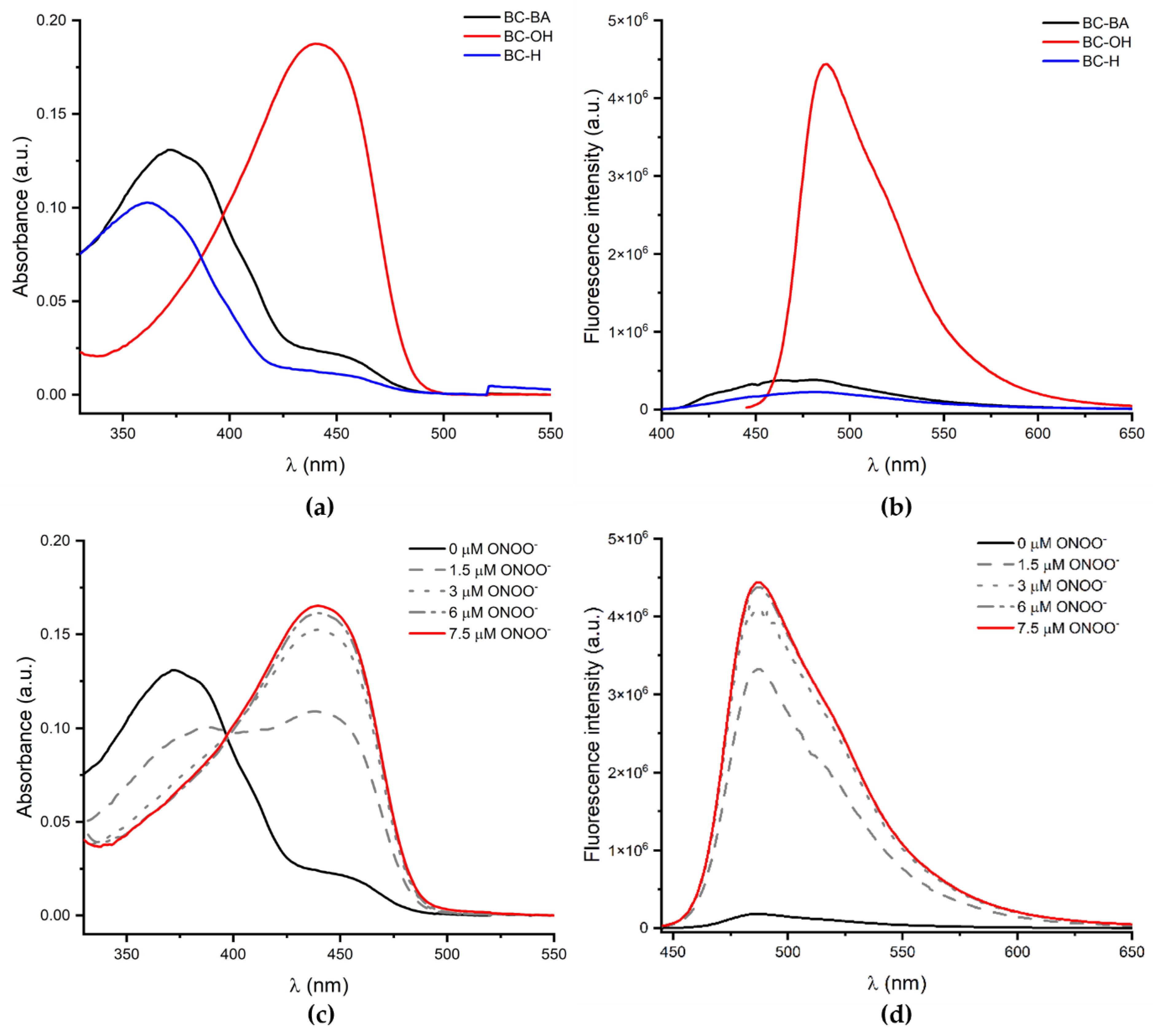
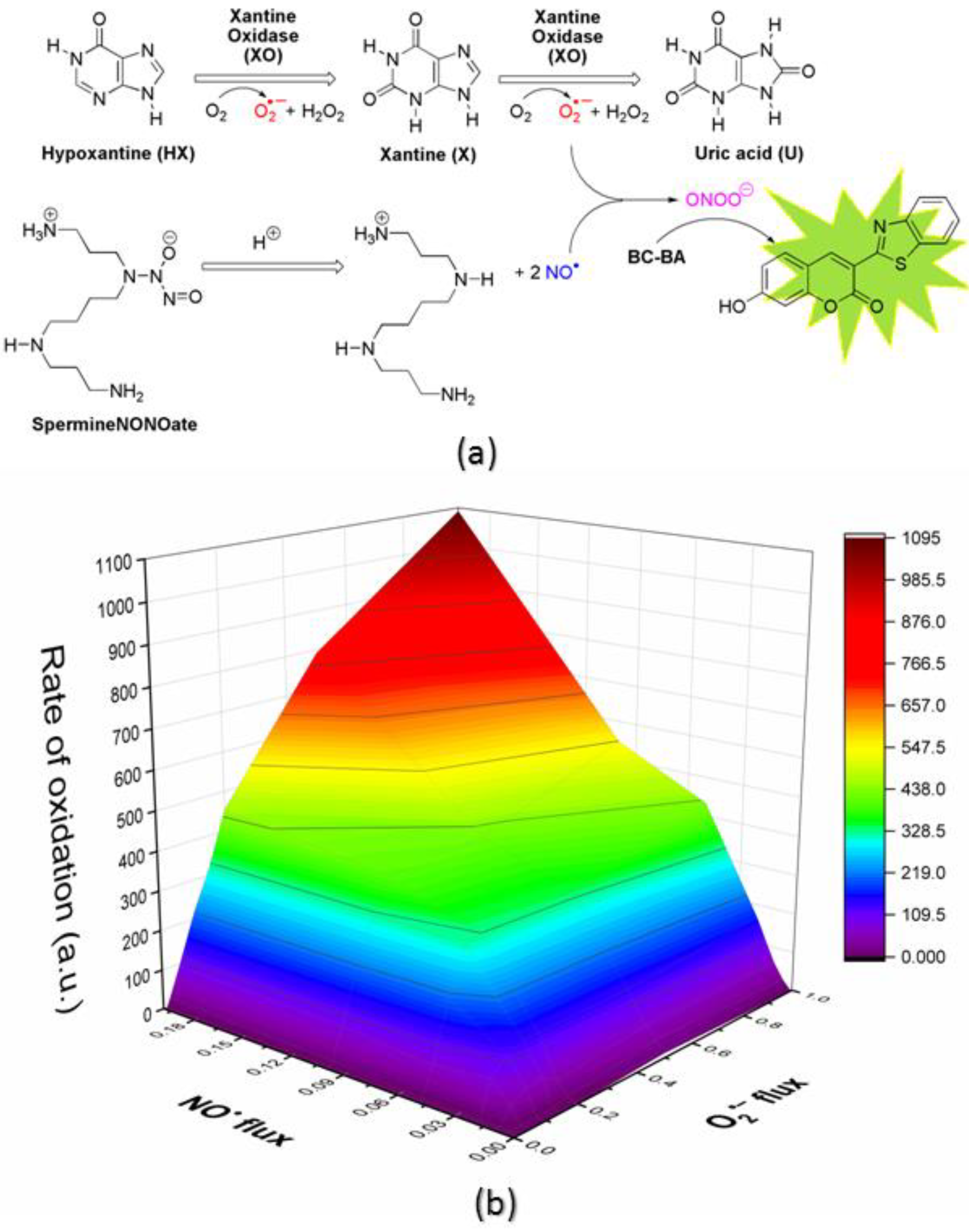
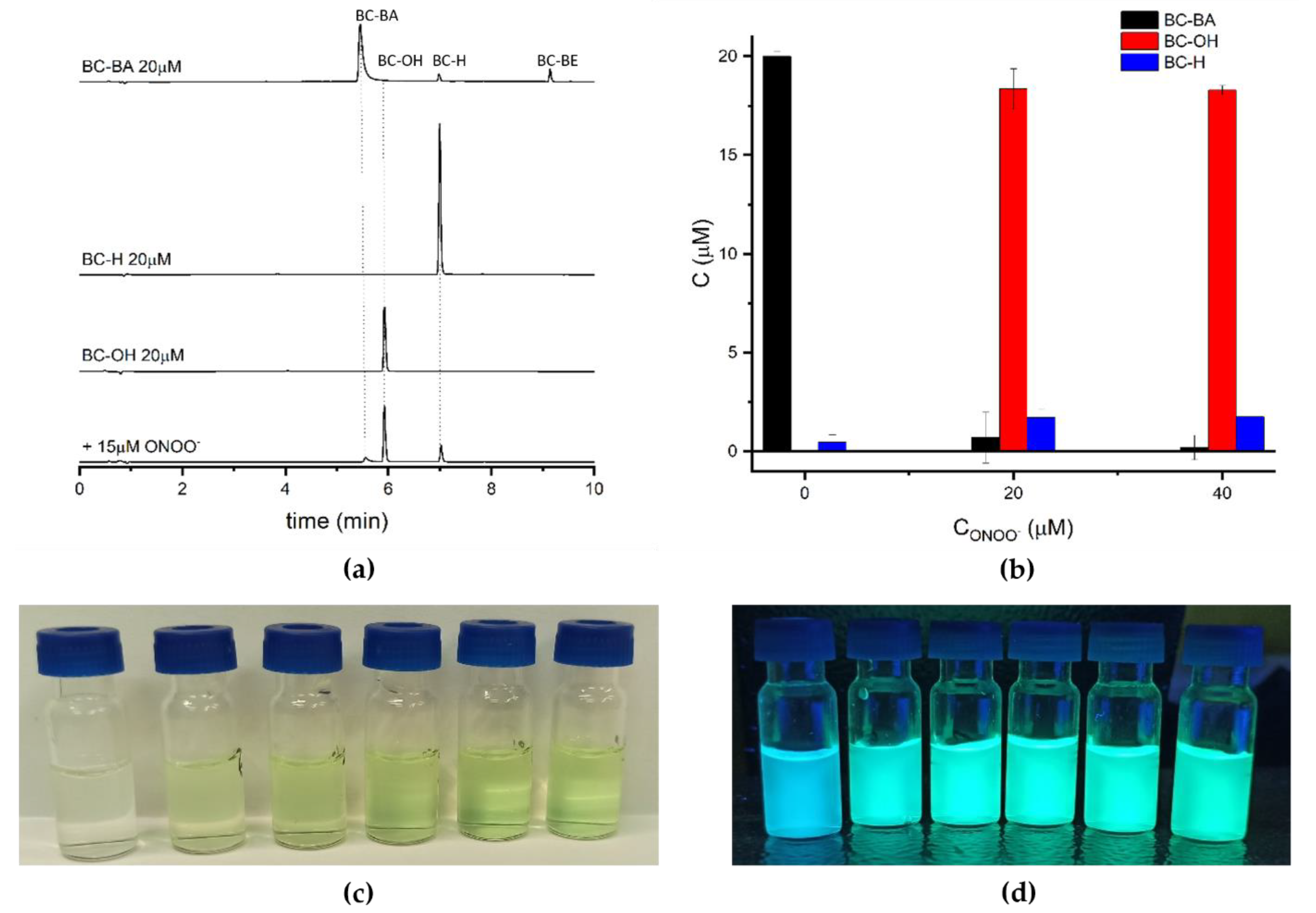
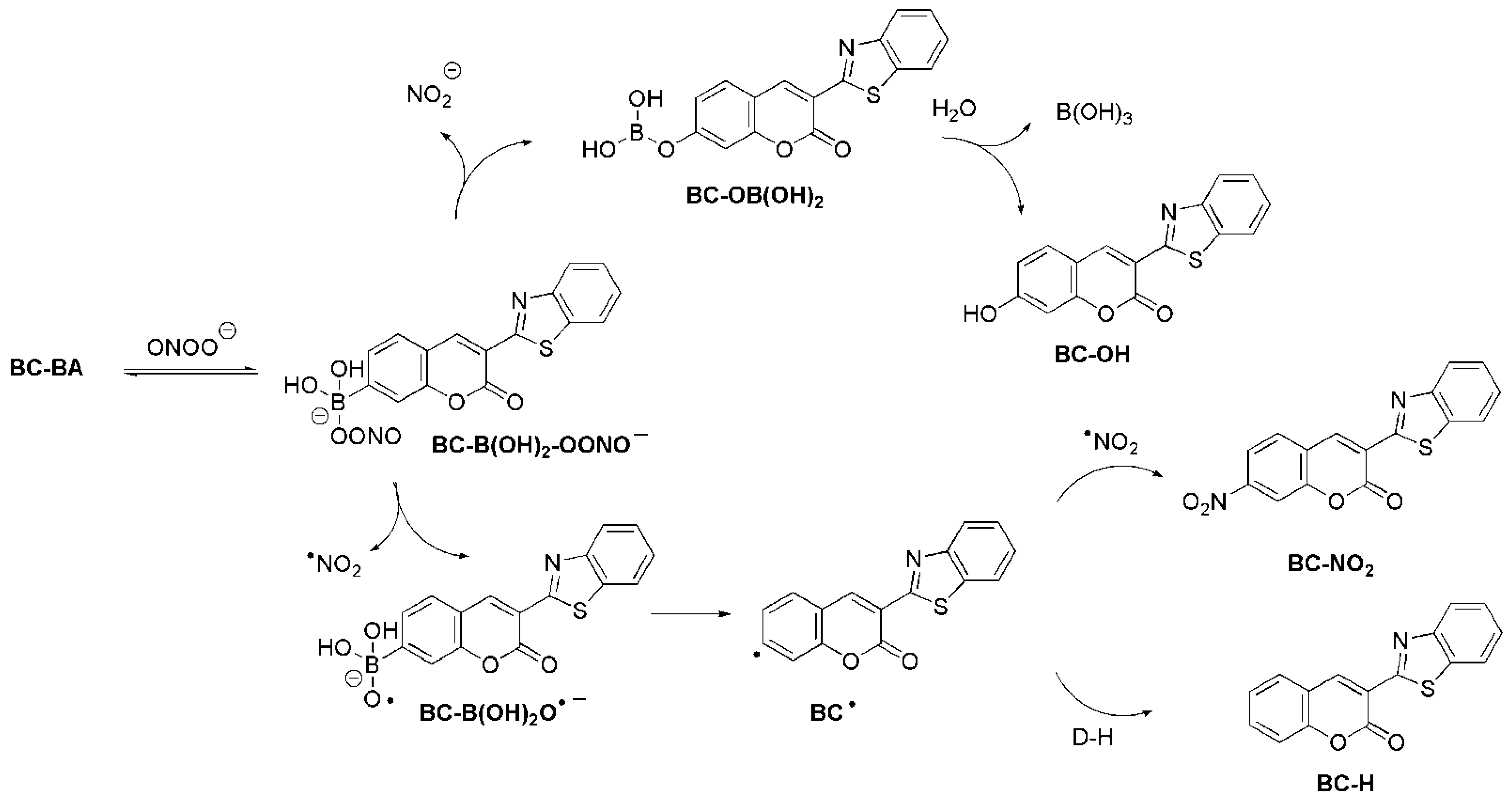
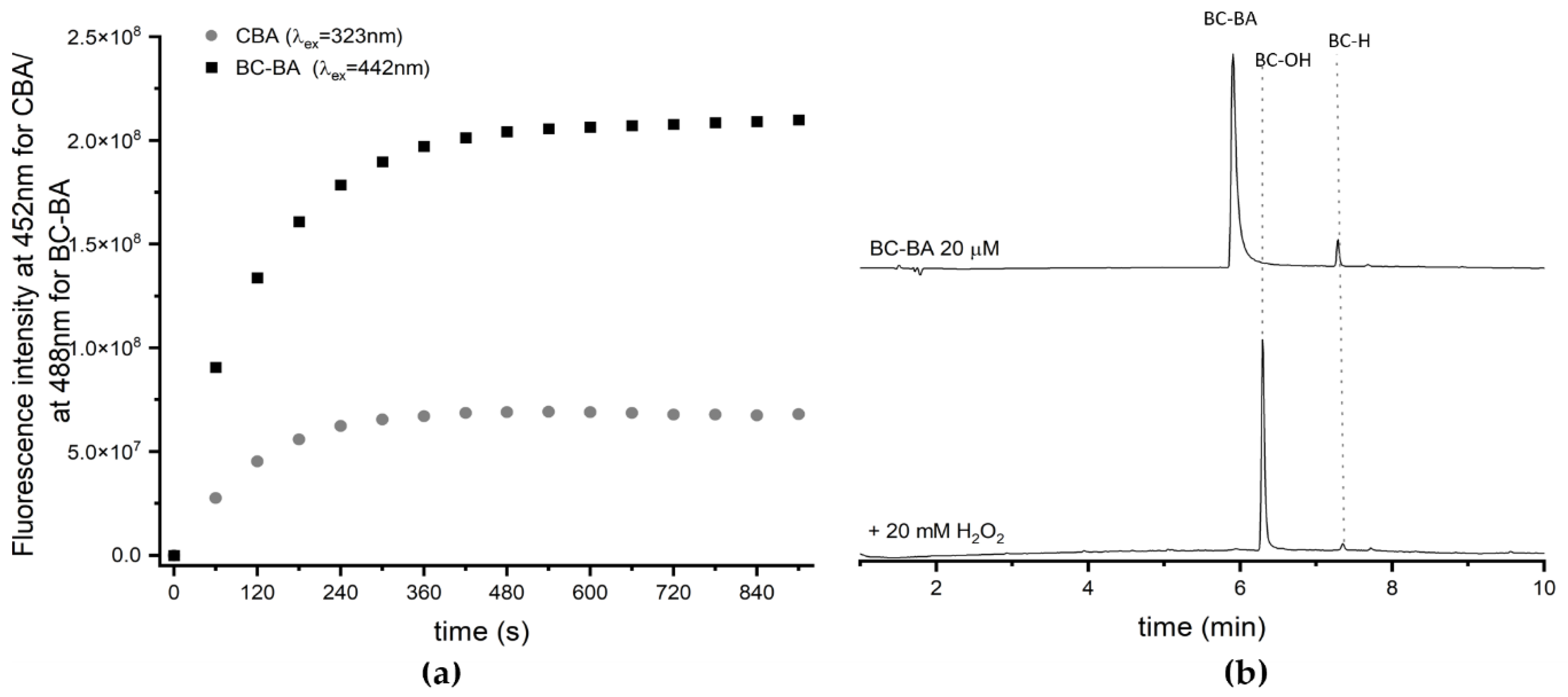
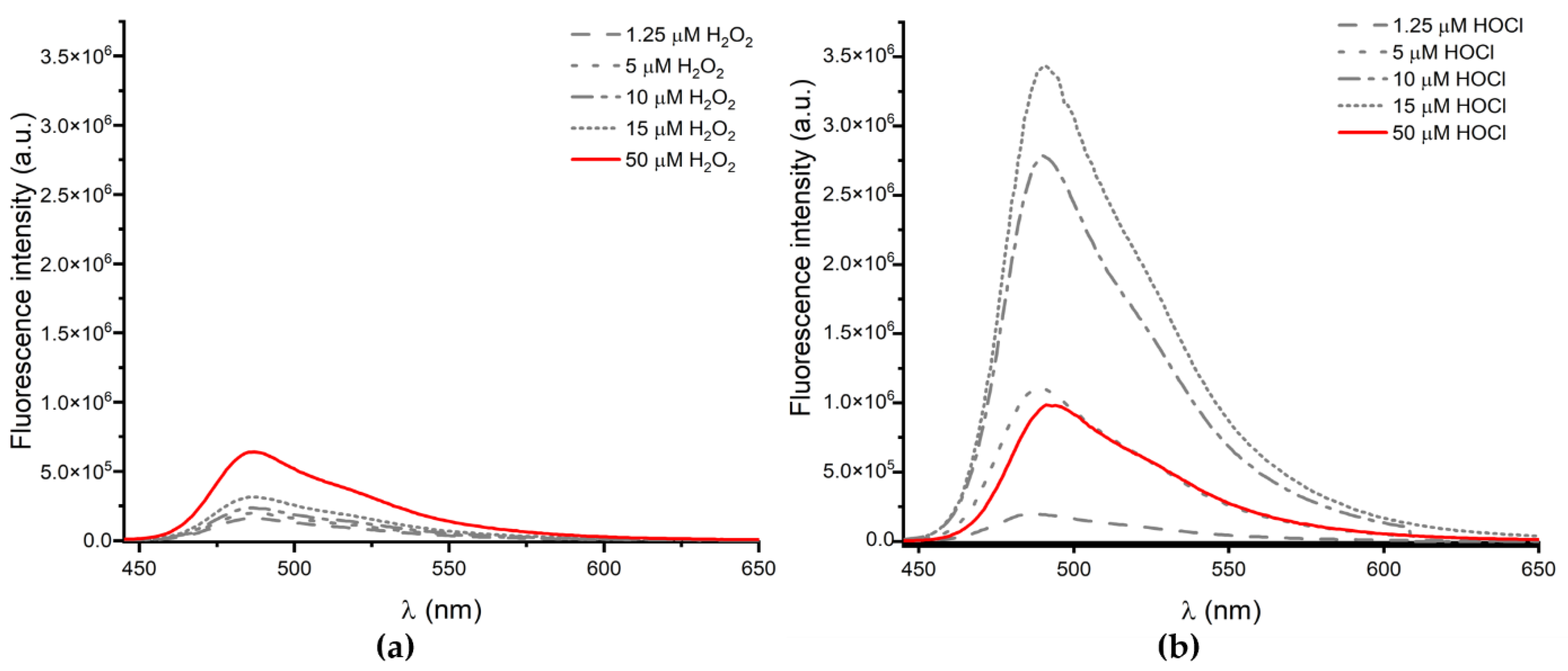
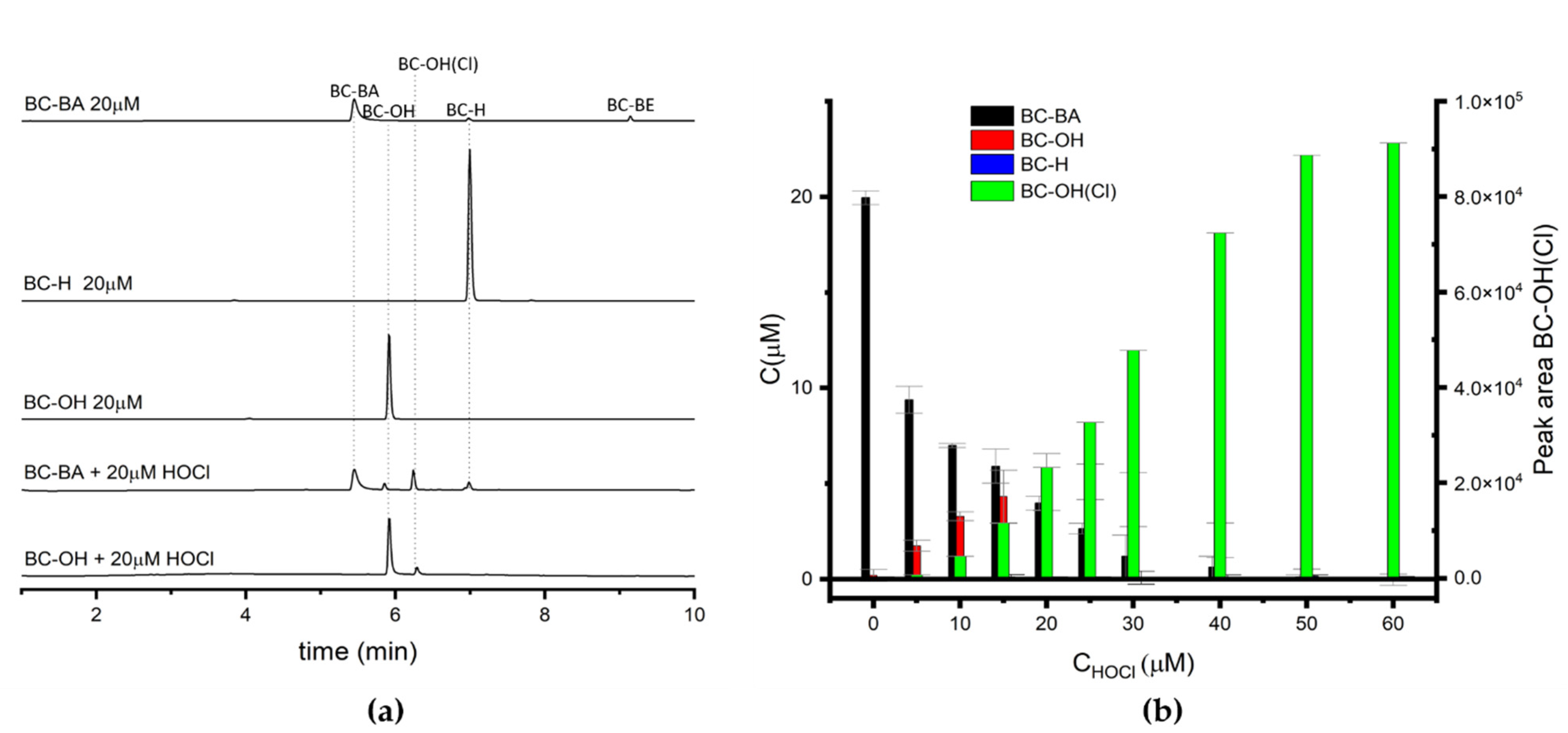


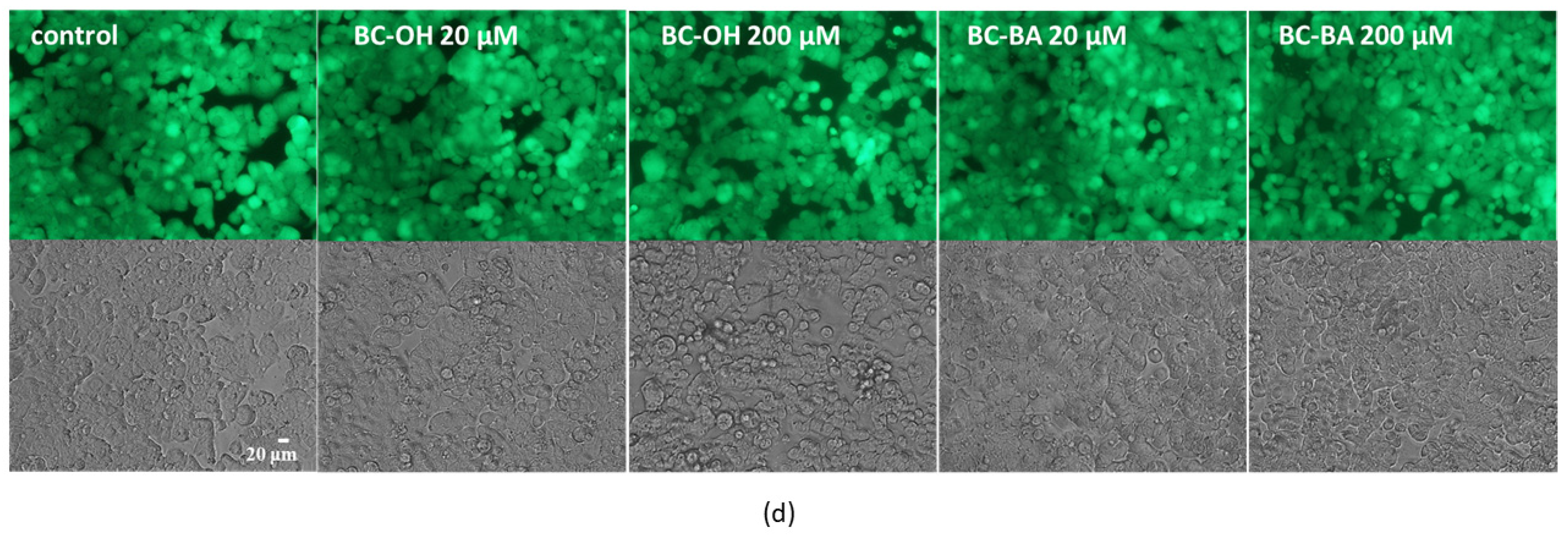
| Solvent | λmax [nm] | ε [104 M−1 cm−1] | λex [nm] | λem [nm] | Stokes Shift [nm] | Φem | τ [ns] 5 | |
|---|---|---|---|---|---|---|---|---|
| COH | EtOH | 326 | 1.22 | 326 | 391 | 65 | 0.10 | |
| H2O 1 | 323 | 1.27 | 323 | 452 | 129 | 0.80 3 (0.76) 4 | ||
| BC-OH | EtOH | 396 | 3.30 | 396 | 467 | 71 | 0.70 3 | 3.07 |
| EtOH:PB 2 | 442 | 3.81 | 442 | 488 | 46 | 0.85 3 | 3.32 | |
| BC-H | EtOH | 364 | 2.36 | 364 | 464 | 100 | 0.14 3 | 1.00 |
| EtOH:PB 2 | 365 | 2.72 | 365 | 470 | 105 | 0.09 3 | 1.63 | |
| BC-BA | EtOH | 369 | 2.22 | 369 | 464 | 95 | 0.21 3 | 2.60 |
| EtOH:PB 2 | 371 | 2.55 | 371 | 473 | 102 | 0.17 3 | 1.33 |
Publisher’s Note: MDPI stays neutral with regard to jurisdictional claims in published maps and institutional affiliations. |
© 2021 by the authors. Licensee MDPI, Basel, Switzerland. This article is an open access article distributed under the terms and conditions of the Creative Commons Attribution (CC BY) license (https://creativecommons.org/licenses/by/4.0/).
Share and Cite
Modrzejewska, J.; Szala, M.; Grzelakowska, A.; Zakłos-Szyda, M.; Zielonka, J.; Podsiadły, R. Novel Boronate Probe Based on 3-Benzothiazol-2-yl-7-hydroxy-chromen-2-one for the Detection of Peroxynitrite and Hypochlorite. Molecules 2021, 26, 5940. https://doi.org/10.3390/molecules26195940
Modrzejewska J, Szala M, Grzelakowska A, Zakłos-Szyda M, Zielonka J, Podsiadły R. Novel Boronate Probe Based on 3-Benzothiazol-2-yl-7-hydroxy-chromen-2-one for the Detection of Peroxynitrite and Hypochlorite. Molecules. 2021; 26(19):5940. https://doi.org/10.3390/molecules26195940
Chicago/Turabian StyleModrzejewska, Julia, Marcin Szala, Aleksandra Grzelakowska, Małgorzata Zakłos-Szyda, Jacek Zielonka, and Radosław Podsiadły. 2021. "Novel Boronate Probe Based on 3-Benzothiazol-2-yl-7-hydroxy-chromen-2-one for the Detection of Peroxynitrite and Hypochlorite" Molecules 26, no. 19: 5940. https://doi.org/10.3390/molecules26195940
APA StyleModrzejewska, J., Szala, M., Grzelakowska, A., Zakłos-Szyda, M., Zielonka, J., & Podsiadły, R. (2021). Novel Boronate Probe Based on 3-Benzothiazol-2-yl-7-hydroxy-chromen-2-one for the Detection of Peroxynitrite and Hypochlorite. Molecules, 26(19), 5940. https://doi.org/10.3390/molecules26195940








